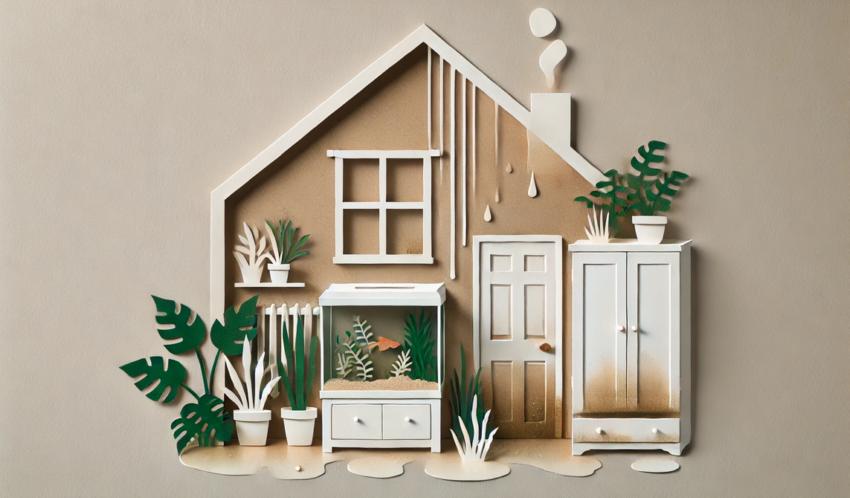Your Fish Tank Is More Sinister Than It Looks
A fish tank may look like an innocent aquatic paradise, but it’s also a moisture factory. Water evaporates constantly, especially in warm rooms, adding to your home’s humidity levels. If you’ve got a sizable tank (or, let’s be honest, multiple tanks because one was never enough), you might as well be running a mini tropical rainforest indoors.The solution? Invest in a lid for your tank, and if your fish happen to be the air-breathing variety that enjoys some open space, consider a dehumidifier nearby. Alternatively, teach your fish to appreciate drier air. It won’t work, but at least you tried.
Indoor Gardening: The Moisture Menace
Your jungle-inspired indoor garden may be great for Instagram, but it’s also fantastic at keeping your home uncomfortably damp. Plants release moisture through transpiration (basically, botanical sweating), and the more plants you have, the more humid your space becomes.Worse yet, overwatering is practically an Olympic sport among enthusiastic plant parents. That excess water has to go somewhere, and more often than not, it ends up evaporating into your home’s air or seeping into the walls and floors. If your houseplants have fungus gnats happily buzzing around, chances are you’ve created the perfect damp breeding ground.
To keep your home from feeling like a tropical greenhouse, try grouping plants in well-ventilated areas and using a moisture meter to avoid overwatering. Or, you know, just accept that your fiddle-leaf fig is plotting against you.
Poorly Positioned Home Insulation: A Hidden Moisture Trap
Insulation is supposed to keep your home warm and dry, but when installed incorrectly, it can have the opposite effect. If moisture gets trapped behind insulation, it has nowhere to escape, leading to hidden condensation and mold growth. This is especially common in older homes where insulation has been retrofitted without proper ventilation.The issue often arises in attics, walls, and floors where insulation blocks airflow, turning your home’s structure into a damp sponge. If you’ve noticed a mysterious musty smell but can’t pinpoint its source, it might be lurking behind those walls like a ghost—only moldier.
The best approach? Ensure that any insulation is paired with proper ventilation. If you’re dealing with an existing problem, don’t just add more insulation and hope for the best. That’s like throwing a blanket over a puddle and expecting it to dry.
The Curse of the Too-Cozy Laundry Room
Ah, laundry day—the day your home turns into a personal steam room. Drying clothes indoors releases an astonishing amount of moisture into the air, and if you’re using a drying rack in a poorly ventilated room, you might as well be watering the walls.Tumble dryers with vent hoses help, but if yours is improperly vented (or worse, venting directly into the house), congratulations! You’ve just created the ideal conditions for condensation to settle in like an unwanted houseguest.
To fix this, always dry clothes outside when possible or use a properly vented tumble dryer. If neither option works for you, invest in a dehumidifier and accept that your home will forever carry the faint scent of fabric softener.
That Stylish But Stifling Furniture Placement
You might have spent hours arranging your furniture for optimal aesthetics, but if you’ve got wardrobes, bookcases, or sofas snug against exterior walls, you may be unintentionally creating damp havens.When large furniture blocks airflow, warm indoor air can’t circulate properly, leading to condensation buildup behind these objects. That’s why you sometimes discover an unexpected patch of mold when moving furniture—an unpleasant surprise nobody asked for.
A simple solution is to leave a gap of at least a few inches between heavy furniture and exterior walls to allow air to flow freely. Yes, it might slightly mess with your interior design plans, but so does peeling wallpaper and an unexpected mushroom colony.
Steamy Showers and Closed Doors: The Bathroom Problem
Bathrooms are naturally damp environments, but if you’re sealing in steam by keeping the door shut after a hot shower, you’re inviting moisture buildup to linger long after you’ve finished belting out your shower-time ballads.Trapped steam condenses on surfaces, seeping into grout, paint, and even wooden fixtures. Over time, this turns your bathroom into a breeding ground for mold and mildew.
To avoid this, always use an extractor fan (or crack a window open) and leave the door slightly ajar after showering. Or, if you enjoy the sauna experience, just make peace with the fact that your bathroom will one day develop its own ecosystem.
Moisture Be Gone! (Or At Least Keep It in Check)
Your home might be unwittingly conspiring against you, but with a little vigilance, you can fight back. Managing indoor humidity levels, ensuring proper ventilation, and keeping an eye on sneaky damp hotspots can save you from dealing with peeling paint, musty odors, and the dreaded appearance of mold.So, if your house has been feeling a little too… damp lately, don’t just blame the weather. Take a good look around. Somewhere, something in your home is quietly pumping moisture into the air and chuckling to itself. Probably your fish tank.
Article kindly provided by homebuildingandsurveyingcompany.co.uk


